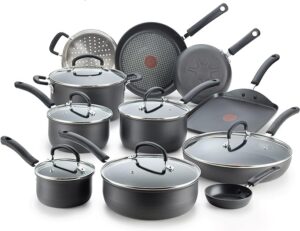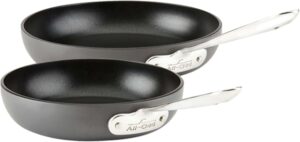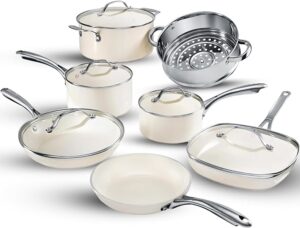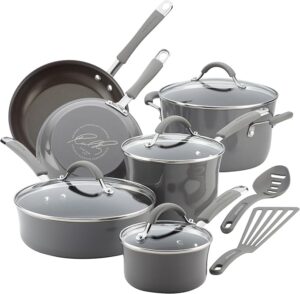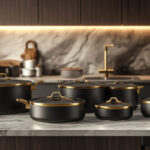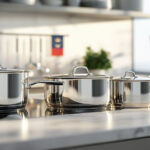What Non-Stick Materials Does Tefal Use? A Deep Dive into PTFE, Ceramic, and Titanium Coatings
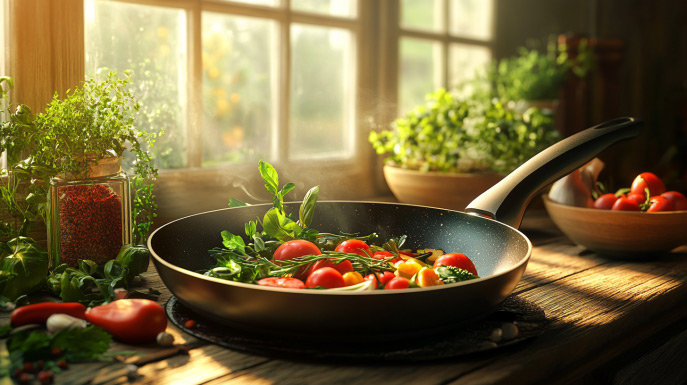
In the search for safe non-stick cookware, Tefal stands out as an innovator in offering a variety of coatings designed to make cooking easier and a lot healthier. Whether one is a professional chef or an amateur homemaker, being certain of the materials involved in Tefal’s trademarked non-stick surfaces will assist you in making informed decisions about the safety and performance of your kitchen tools. In this article, we will go through various types of non-stick coatings employed by Tefal, such as PTFE, ceramic, and titanium, and look at their respective advantages, safety concerns, and durability to guide you in choosing the best cookware suited to your needs.
What Is PTFE and Why Does Tefal Use It?
PTFE is a synthetic polymer that has become a cornerstone in nonstick cookware, and Tefal remains one of the most recognized brands making use of the product. Known for its very exceptional nonstick characteristics, PTFE creates a slick surface that prevents food from sticking; both cooking and cleaning become a great deal easier.
Tefal chose PTFE for their non-stick cookware because of its excellent heat resistance, durability, and chemical inertness. It will not decompose at high cooking temperatures, thus assuring long-life non-stick performance. More importantly, PTFE is also known as a safe cooking material provided its use is made under prescribed conditions, normally not higher than 260°C or 500°F.
One of the most major reasons why PTFE is used so widely-the question of safety-is manifested in the very fact that when used properly, it does not react with food and vice versa. Those who are searching for really harmless non-stick cookware rely on Tefal’s pans with a PTFE coating because they have proved to be one of the best options that correspond to the standards of cookware safety.
Is PTFE (Teflon) Safe for Everyday Cooking?
PTFE is one of the most common non-stick coatings used in cookware, popularly known by the brand name Teflon. Its non-sticking action makes it a cook’s delight for day-to-day cooking, but its safety is always in question. So, the question is, is PTFE safe to use in your kitchen regularly?
PTFE has been declared safe under normal conditions of use while cooking. The important thing to remember is not to overheat cookware, because the breakdown of PTFE-coated pans begins at temperatures higher than 260°C, which may release fumes that cause symptoms like flu in humans and are harmful to pets-especially birds. In common cooking, however-sauteing, frying, or simmering, for example-PTFE is stable and safe.
The other major reason is that PTFE is chemically inert. It doesn’t react with food or leach harmful chemicals into your meals, provided it has been used correctly. For those in search of safe cookware, PTFE offers convenience, efficiency, and peace of mind, though one will have to be careful, avoiding cooking at high heat, hence suitable for everyday use in the kitchen.
Alternatives to Teflon: Ceramic and Titanium Non-Stick Coatings
But as health-conscious consumers seek out safer alternatives in the kitchen, several alternatives to Teflon non-stick cookware have gained momentum. Two leading contenders for non-stick surfaces without the potential concerns linked to PTFE include ceramic and titanium coatings. Let’s take a closer look at these alternatives to Teflon and why they just may be what you need in your kitchen.
Ceramic Non-Stick Coatings
Ceramic coatings are one of the most popular alternatives to Teflon because they boast a very friendly composition to the environment and have naturally non-stick properties. Due to the fact that they are manufactured from silica-based materials, they do not contain PTFE or PFOA-a chemical used in making PTFE. The complete absence of synthetic chemicals attracts those people who seek non-toxic kitchen utensils.
Benefits of Ceramic:
- Safety and Health: Ceramic coating does not contain toxic chemicals, such as PTFE and PFOA; thus, it is safer, especially when higher temperature cooking is involved.
- Heat Resistance: Unlike PTFE, ceramic withstands high cooking temperatures up to 450°C or 850°F, making it much stronger concerning very high temperatures.
- Eco-friendly: Generally, production is greener in the manufacture of ceramic coatings because natural minerals are used, emitting fewer pollutants into the environment.
However, the ceramic coating mostly remains less durable than PTFE, since it loses its non-stick properties over time, especially when used under high heat or not well taken care of. On the other hand, they still remain one of the best recommendations if safety and environmental concerns are brought forward.
Titanium Non-Stick Coatings
However, the option that is closely related yet somewhat more interesting is the Titanium-reinforced coatings. Not genuinely non-stick on their own, the titanium is often alloyed with other non-stick materials such as ceramics or PTFE to further enhance durability and scratch resistance. Some cookware from the line of Titanium does not use PTFE at all; it offers a different idea behind safe non-stick cooking.
Benefits of Titanium:
- Superior Durability: The coats made of titanium are very hard and tough. They do not scratch easily, and therefore, they can be used with metal utensils, and they keep their non-sticking feature over time.
- Health and Safety: Used with ceramic, titanium coatings become a PTFE-free option-safe even when exposure to high temperatures occurs. The nature of titanium makes it hypoallergic and nontoxic by default.
- Lightweight and Efficient: Generally, titanium-coated cookware will be much lighter and heat evenly, making cooking efficient.
The above-mentioned features of titanium-reinforced cookware most often demand a higher price, but durability with long-lasting non-stick performance justifies the investment.
Also read: What customers say about different types of T-fal (Tefal) pan?
Choosing the Right Teflon Alternative
Both ceramic and titanium coatings provide excellent alternatives to traditional Teflon cookware, each with unique advantages. Ceramic provides a completely PTFE-free cooking surface, which appeals to eco-conscious consumers, while titanium coatings are well-recognized for their durability and versatility.
In choosing a safer version of non-stick cookware, consider your cooking style, budget, and preference for chemical-free material. You can choose either ceramic or titanium; both ways, you will have a fairly decent performance of the non-stick without the possible health risks of Teflon.
PFOA-Free, Lead-Free, and Cadmium-Free: How Safe Is Tefal’s Cookware?
As people start to be more conscious about the materials in their kitchen things, words such as “PFOA-free,” “lead-free,” and “cadmium-free” become essential as people evaluate the safety of cookware. Tefal, a leading brand in the non-stick cookware industry, has responded by developing products in line with high safety standards. But just how safe is Tefal’s cookware, and what does it really mean? Here’s why Tefal is making sure that its cookware line does not have chemicals to make it a trusted choice for those seeking Teflon alternatives and much safer cooking solutions.
Understanding PFOA-Free Cookware
PFOA was a chemical used in the process of manufacturing PTFE, better known as Teflon, applied to pans to make them non-sticky. Considering studies that have shown PFOA is persistent both in the environment and the human body, serious questions have been raised about health effects, even a possible linkage to certain types of cancers.
In fact, like many other high-end cookware brands, Tefal has taken the exclusion of PFOA completely out of the manufacturing process. All Tefal cookware is currently marketed as PFOA-free; quite frankly, no inclusions at all have been made in the processes used for the creation of the non-stick coating. This means that the Tefal cookware will be able to come up to today’s health standards regarding modern health standards and long-term exposure to hazardous chemicals.
Lead-Free and Cadmium-Free Cookware
In addition to being free from PFOA, the non-stick cookware by Tefal is also lead-free and cadmium-free, meaning that these toxic heavy metals are not used in its coatings. The ingestion of lead and cadmium over time has severe health implications, including poisoning that may lead to the malfunction of vital organs and developmental problems. Trace amounts of these metals were sometimes found in older materials for cookware, most specifically ceramic or enamel types, thus raising concerns over their safety.
Tefal assuredly makes them quite safe for any customer in search of cookware that will not leach dangerous chemicals into their food by ensuring the cookware is free from lead and cadmium. In this respect, its products will be especially alluring to families and other people who pay much regard to health and safety in the kitchen.
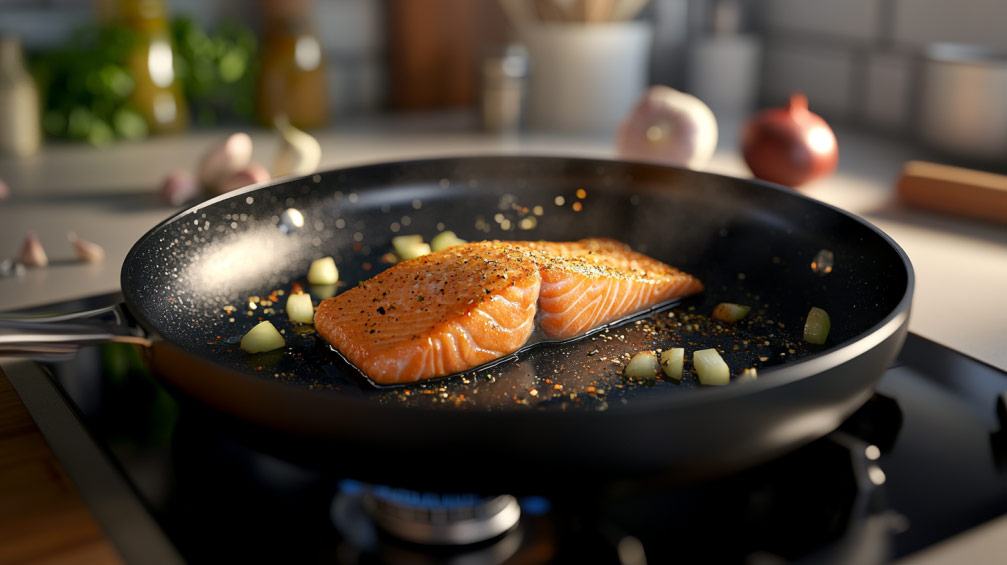
Teflon Alternatives: What Does Tefal Use?
While Tefal uses PTFE in some cookware lines, the absence of PFOA makes it a safer alternative for non-stick cooking. The PTFE, taken by itself, is not harmful; it is used within the recommended temperature limits, usually below 260°C/500°F. For those consumers who would want to avoid Teflon at all costs, Tefal has several lines with a ceramic coating; this provides a PTFE-free alternative to nonstick cookware and is synthetic chemical-free.
Ceramic coatings are, by nature, non-stick, and with the additional advantage of sustaining higher temperatures without degradation. This will make ceramic-coated cookware an ideal choice for those people who are very concerned about the safety of synthetic coatings. Tefal’s ceramic lines boast a fully PTFE-, PFOA-, lead-, and cadmium-free construction, which places them in a solid position in the health-conscious home cook’s options.
Is Tefal’s Cookware Safe?
Tefal guarantees the production of PFOA-free, lead-free, and cadmium-free cookware to meet the highest standards of safety. Whether one chooses traditional PTFE coating or higher-class non-stick alternatives in a ceramic base, Tefal has something to fit consumer health desires.
Tefal cookware, on the other hand, is not only safe to use if used correctly but also convenient, making healthier cooking possible with lesser oil. This is because Tefal also adheres to very stringent safety regulations in all its dealings, therefore making their brand trustworthy in providing nontoxic and dependable cookware.
Conclusion: A Trusted Choice for Safe Non-Stick Cookware
Continuing concerns over chemicals used in the kitchen set Tefal at the forefront of offering PFOA-free, lead-free, and cadmium-free cookware. Be it Teflon alternatives using ceramic coatings or if you prefer the durability of PTFE with modern safety standards, Tefal has a wide set of options.
Indeed, Tefal stays on top of every consumer’s mind seeking safe non-stick cookware. It has brought a wide range of products that ensure performance with peace of mind so one can cook with confidence.
Comparing Non-Stick Surfaces: Which One Should You Choose?
In selecting non-stick cookware, one is faced with a number of choices, all with their relative advantages and limitations. Among such choices are PTFE or Teflon, ceramic, and titanium-reinforced coatings, all promising to give non-sticking experiences. But how safe, durable, and performant is this material? Now, to the serious business of weighing pros against cons for each type of non-stick surface to make the choice in the kitchen a little easier.
More tips about tefal pans in “What Materials are Used in Tefal Pans? Exploring Non-Stick and Eco-Friendly Coatings“
PTFE (Teflon)
PTFE is often better known as Teflon, and for many years, it has been used in non-stick cookware. This is a widely used material because of its very superior non-stick capability, making cooking and cleaning very easy.
Pros:
- Extremely good non-stick performance: PTFE-coated pans are among the best regarding preventing food from sticking and thereby being able to reduce the need for oil.
- Affordable: Generally speaking, PTFE cookware is cheaper compared to other non-stick alternatives.
- Ease of use: This pan is perfect for low to medium heat cooking, and it’s very easy to clean and maintain.
Cons:
- Heat sensitivity: PTFE coatings tend to degrade and emit noxious fumes when their temperature exceeds 260°C (500°F)-something highly toxic at high levels.
- Chemical concerns: Although most cookware with PTFE coating today is free from PFOA, recently, long-term ecological safety related to PTFE has come into question.
For whom is PTFE most suitable? PTFE cookware would be an ideal choice if you desired effective, non-stick cookware but at an affordable price because you do not usually cook under high temperatures. However, the only thing that needs to be looked after is not crossing the heat limits.
Ceramic Non-Stick
Ceramic cookware has gained quite a bit of popularity due to its eco-friendly alternatives free from PTFE and PFOA. Its non-stick characteristics are from the silica-based coating hence giving a smooth surface without the use of synthetic chemicals.
Pros:
- Chemical-free: Ceramic coatings are free from PTFE, PFOA, and other potentially harmful chemicals.
- High-heat resistant: Compared to PTFE, ceramic cookware allows higher temperatures, a maximum of 450°C or 850°F, thus performing well in various cooking techniques.
- Friendly to the environment: Ceramic coatings tend to be more friendly to the environment because of their less harming production way.
Cons:
- Over time and heavy use at high temperature or poor maintenance might make the ceramic coating worn off.
- Although it might work fine at the beginning, the non-stick quality of ceramic coatings can degrade faster than those of PTFE or titanium.
Who should opt for ceramic? Those more into ‘green’ cookware material and who would wish to avoid chemicals such as PTFE and PFOA should opt for ceramic. On the other hand, it would be better if one were not to mind changing dishes quite often or keeping them very well so that the non-stick layer is preserved.
Titanium-Reinforced Non-Stick
Normally, the non-stick coating is made of titanium reinforcement combined with other materials that are traditionally used for their non-stick properties, such as ceramic or PTFE. Purely taken, titanium is amazingly resistant to scratches, and it is very durable.
Pros:
- Durability: Generally, cookware reinforced with titanium is very durable; it resists scratches and wear and tear, even against the frequent use of metal utensils.
- Versatility: Several titanium cookware welds the non-stick properties of PTFE or ceramic with the strength of titanium, hence promising a long-standing use with its non-stick features.
- Chemical Safety: Most of these titanium-reinforced coatings are free from PTFE and PFOA for much safer cooking surfaces against the concerns of health-conscious users.
Cons
- Price Generally, titanium-reinforced cookware is more expensive because of the materials applied and its long-lasting nature.
- Not pure titanium: Even though promoted as titanium, more often than not, the coating comes from combined materials; therefore, one might want to check whether the coating of PTFE or any other chemicals applied is a concern to take into consideration.
For whom? Titanium strengthened, if looking for very durable, versatile non-stick cookware that can handle the rigors of daily cooking with metal utensils. Perfect for people who have no qualms investing a bit more in something promising to perform well and stay safe for a longer period.
“Should I Buy T-fal Hard Anodized Nonstick 17-Piece Cookware Set?”
Comparing Non-Stick Surfaces: Key Considerations
Following are some factors to help you decide which non-stick surface will serve your needs best:
- Safety: If it is imperative that the cookware be chemical-free and nontoxic, then ceramic and titanium reinforcement-in cookware not coated with PTFE-are safer alternatives. Of course, PTFE cookware can be safe, but you will need to avoid high-heat cooking to prevent breakdown of the coating.
- Durability: For non-stick performance, Titanium cookware is the most durable and able to withstand rougher handling. Ceramic coatings tend to be less strong, especially over time, while PTFE coatings might wear out if abused improperly or overheated.
- Performance: PTFE provides the most uniform non-stick performance and is quite suitable for everyday use. At the beginning, ceramic coating is very effective; in this case, however, the properties of the non-stick effect can be lost sooner. Titanium-reinforced pans offer a balanced solution: excellent performance combined with improved durability.
- Price: It is mostly observed that the prices for PTFE cookware are rather low, while titanium-reinforced cookware is really expensive because it is very durable. Ceramic cookware falls in between, banking on the use of environment-friendly materials.
Conclusion: Which Should You Choose?
- If the best non-stick performance at a low price is what you are looking for, without qualms about medium to low heat, then PTFE cookware should be quite a good option.
- Those who like to go greener and avoid chemicals will have no problem with maybe having to replace their cookware after a while; ceramic is an excellent choice.
- While a little pricey for some consumers, to those who believe in durability and performance that stays, there’s nothing like titanium-reinforced cookware.
Basically, it’s all about cooking style, priority concerns on safety, and one’s budget. Each material has strengths of its own, so it depends on which one fits in your kitchen best.

